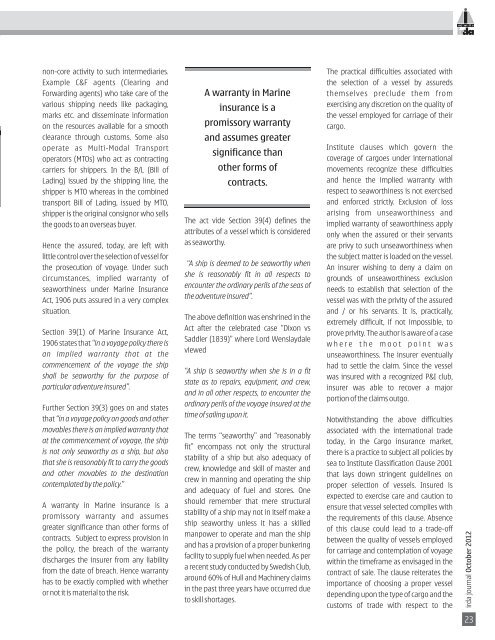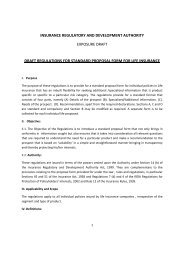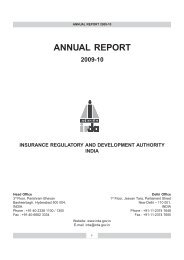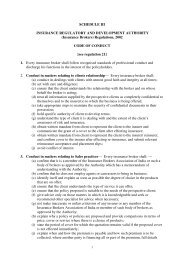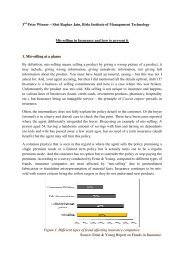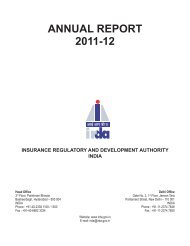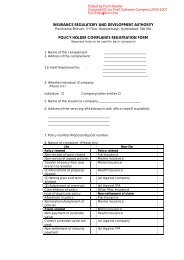'ÃÄ ÃflßĸÄ⧠â¢Ä±âU Ãflâ§Äâ ŽËÄÃÅâ§âUÃ¡Ä - IRDA
'ÃÄ ÃflßĸÄ⧠â¢Ä±âU Ãflâ§Äâ ŽËÄÃÅâ§âUÃ¡Ä - IRDA
'ÃÄ ÃflßĸÄ⧠â¢Ä±âU Ãflâ§Äâ ŽËÄÃÅâ§âUÃ¡Ä - IRDA
You also want an ePaper? Increase the reach of your titles
YUMPU automatically turns print PDFs into web optimized ePapers that Google loves.
non-core activity to such intermediaries.Example C&F agents (Clearing andForwarding agents) who take care of thevarious shipping needs like packaging,marks etc. and disseminate informationon the resources available for a smoothclearance through customs. Some alsooperate as Multi-Modal Transportoperators (MTOs) who act as contractingcarriers for shippers. In the B/L (Bill ofLading) issued by the shipping line, theshipper is MTO whereas in the combinedtransport Bill of Lading, issued by MTO,shipper is the original consignor who sellsthe goods to an overseas buyer.Hence the assured, today, are left withlittle control over the selection of vessel forthe prosecution of voyage. Under suchcircumstances, implied warranty ofseaworthiness under Marine InsuranceAct, 1906 puts assured in a very complexsituation.Section 39(1) of Marine Insurance Act,1906 states that “in a voyage policy there isan implied warranty that at thecommencement of the voyage the shipshall be seaworthy for the purpose ofparticular adventure insured”.Further Section 39(3) goes on and statesthat “in a voyage policy on goods and othermovables there is an implied warranty thatat the commencement of voyage, the shipis not only seaworthy as a ship, but alsothat she is reasonably fit to carry the goodsand other movables to the destinationcontemplated by the policy.”A warranty in Marine insurance is apromissory warranty and assumesgreater significance than other forms ofcontracts. Subject to express provision inthe policy, the breach of the warrantydischarges the insurer from any liabilityfrom the date of breach. Hence warrantyhas to be exactly complied with whetheror not it is material to the risk.A warranty in Marineinsurance is apromissory warrantyand assumes greatersignificance thanother forms ofcontracts.The act vide Section 39(4) defines theattributes of a vessel which is consideredas seaworthy.“A ship is deemed to be seaworthy whenshe is reasonably fit in all respects toencounter the ordinary perils of the seas ofthe adventure insured”.The above definition was enshrined in theAct after the celebrated case “Dixon vsSaddler (1839)” where Lord Wenslaydaleviewed“A ship is seaworthy when she is in a fitstate as to repairs, equipment, and crew,and in all other respects, to encounter theordinary perils of the voyage insured at thetime of sailing upon it.The terms “seaworthy” and “reasonablyfit” encompass not only the structuralstability of a ship but also adequacy ofcrew, knowledge and skill of master andcrew in manning and operating the shipand adequacy of fuel and stores. Oneshould remember that mere structuralstability of a ship may not in itself make aship seaworthy unless it has a skilledmanpower to operate and man the shipand has a provision of a proper bunkeringfacility to supply fuel when needed. As pera recent study conducted by Swedish Club,around 60% of Hull and Machinery claimsin the past three years have occurred dueto skill shortages.The practical difficulties associated withthe selection of a vessel by assuredsthemselves preclude them fromexercising any discretion on the quality ofthe vessel employed for carriage of theircargo.Institute clauses which govern thecoverage of cargoes under internationalmovements recognize these difficultiesand hence the implied warranty withrespect to seaworthiness is not exercisedand enforced strictly. Exclusion of lossarising from unseaworthiness andimplied warranty of seaworthiness applyonly when the assured or their servantsare privy to such unseaworthiness whenthe subject matter is loaded on the vessel.An insurer wishing to deny a claim ongrounds of unseaworthiness exclusionneeds to establish that selection of thevessel was with the privity of the assuredand / or his servants. It is, practically,extremely difficult, if not impossible, toprove privity. The author is aware of a casewhere the moot point wasunseaworthiness. The insurer eventuallyhad to settle the claim. Since the vesselwas insured with a recognized P&I club,insurer was able to recover a majorportion of the claims outgo.Notwithstanding the above difficultiesassociated with the international tradetoday, in the Cargo insurance market,there is a practice to subject all policies bysea to Institute Classification Clause 2001that lays down stringent guidelines onproper selection of vessels. Insured isexpected to exercise care and caution toensure that vessel selected complies withthe requirements of this clause. Absenceof this clause could lead to a trade-offbetween the quality of vessels employedfor carriage and contemplation of voyagewithin the timeframe as envisaged in thecontract of sale. The clause reiterates theimportance of choosing a proper vesseldepending upon the type of cargo and thecustoms of trade with respect to theirda journal October 201223


